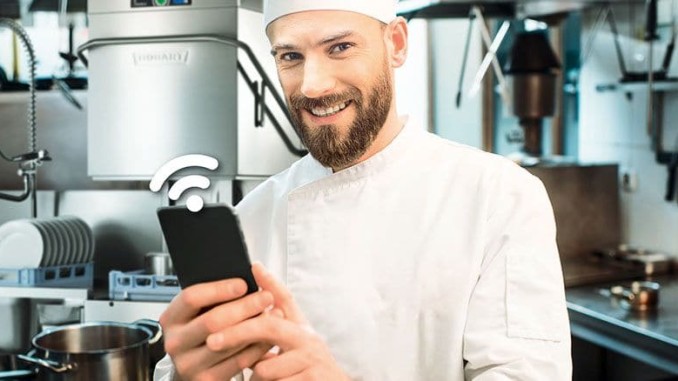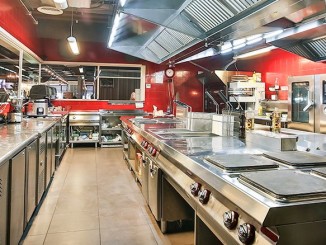
Digitalization and interconnection are the defining innovation pools in the spring of 2017. Being that each investment has to be financed, new means of financing are profoundly exciting too. What’s hot in the spring of 2017 for kitchen technology?
By Dieter Mailander
In recent years, many product developers of commercial kitchen technology have made their equipment and systems more flexible and more adaptable, have reduced consumption figures, and have facilitated their servicing. Today, new focal points are pushing themselves to the forefront, like for instance: digitalization, interconnection, or financing.
Financing & Kitchen Technology
Perhaps at first glance, the innovative connection between financing and kitchen technology doesn’t seem to be evident. But it quickly becomes very clear if one, for instance, considers the situation of hospitals in nine European countries.[i] In six of them, between 22% and 53% of the clinics operate at a high financial risk (only in Belgium, Germany and Switzerland is the situation of less concern). In high risk clinics, the investment backlog has built up. Badly-needed investments have also been stopped due to lack of budgets. The people responsible kitchens are also looking for cost-neutral alternatives in order to replace their old equipment. Their operating costs surpass far above those of modern equipment. Furthermore, the costs due to repairs are rising. At least in Germany, the situation in senior citizens’ homes is often similar.[ii]
Beyond the well-known financial models, Winterhalter, manufacturer of dishwashing systems and dishwashers, has developed a totally new procurement variant with pay per wash. The user doesn’t have to have any assets, doesn’t pay any fixed amount per month either, but pays per washing cycle. For instance, they buy a number of dishwashing cycles per credit card at the manufacturer and receive in return a code. When they insert the card into the dishwasher, they load up their credit balance on the dishwashing cycles, which then works it off. The specialty dealer calculates its costs on the basis of a program, given by Winterhalter. The amount depends on the configuration of the machine and the services of the dealer. A rough guiding figure is 20 to 50 cents per washing cycle. All of expendable materials, repairs, and services are included in this. The specialty dealer collects the money and pays the manufacturer a user fee of 1.5 cents. With the remaining money, the dealer finances his or her services (for instance, ordering chemical cleaning agents service resp. repair services) and generates his or her spread income. All of the device data are transmitted digitalized. That’s why every user has to be interconnected with the specialty dealer and the manufacturer.
Digitalization in all Areas
Digitalization is the processing of information for conversion or storage into systems based on digital technology.[iii] This development makes it possible for the workers in the kitchen team to read and analyze the data of all of the equipment and systems on computers, smart phones or tablets (note: all these pieces of equipment recognize only two signal statuses: zero and one[iv]).
Hobart, manufacturer of dishwashers and dishwashing systems and a division of the US American company, Illinois Tool Works (ITW) solves the issue with Wash Smart per Wi-Fi, internet, and multilingual App, the user receives, among others, an overview of the operation costs (consumption of water, energy and chemical cleaning agents) for all pieces of equipment. The user receives service and error messages as push messages, for instance, if a cleaning agent or regeneration salt has to be refilled or the filter cartridge of the osmosis system has to be replaced. The app informs upcoming service operations in due time. Other features are hygiene protocols, usage analyses, or visualized directions so that the user can eliminate malfunctions.
Interconnection
In simple terms, interconnection means that single components of a system or all of them are connected with each other so that you are able to receive, process, and send data and information. A completely interconnected kitchen has been set up recently in an innovation center in Southern Germany[v], initiated by the entrepreneur, Max Maier, proprietor of the company Rieber GmbH & Co. KG (by its own accounts, leading innovator in food distribution, presentation and serving). Start-ups of well-known companies like Porsche or Bosch, but also totally unknown innovators have settled down in the innovation center. Currently, over 2,000 people are working there and among them 500 engineers from Porsche Digital, who are engaged in car driving in the future under the motto Smart Mobility. At the end of the year, the innovation campus could be filled with 7.000 creative people. The operator of the so-called Flagship Kitchen, a versatile and dedicated Gastronome, produces with his team six dishes daily for 600 to 800 guests on the campus. 430 sqm are available for gastronomy and another 70 sqm for front cooking. He realizes an average of €6.50 per guest. Lunchtime (11:30h to 14:00h) is placed under the motto of Network & Lunch. Whoever would like can take a break, can also take advantage of the bistro (motto Relax and Chill, opening hours 8:30h to 17:00h). The opening hours would be extended if needed. In addition to the lunches on site, the operator produces 2,000 meals for schools.
The cook & chill production runs on 270 sqm, whereby 140 sqm of this are for blast chillers, shock freezers, and other cooling devices. All of the equipment is digitally interconnected; the data is put into a cloud and is downloaded from there to different pieces of equipment. The dishes are transported in reusable containers, which are controlled by Rieber’s own software CHECK. Each dish is provided with a QR code, by which the temperature of the dishes (measuring every ten minutes), the serving times, and storage are being monitored and documented without interruption. Moreover, the entire food flow can be traced by the QR codes from storage to preparation and cooking, transportation up to the serving and can be documented completely for HACCP compliance.
After the spring trade fairs, the industry will experience another innovation push at the HOST in Milan (Oct. 20 – 24, 2017). It will be very interesting!
[i]Accenture and RWI – Leibniz Institute for Economic Research, Europe’s Hospitals: An Industry Operating in the Red, 2014.
[ii] Investment Barometer Altenpflege 2017, Press Office Heckmann, press release, March 14, 2017.
[iii] Wikipedia: keyword digitalization, seen on March 24, 2017.
[iv] Wikipedia: keyword digital technology, seen on March 24, 2017
[v] urbanhabor, Ludwigsburg, near Stuttgart, Germany, www.urban-habor.de



